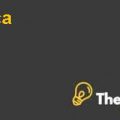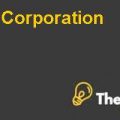
Question 1
How has PepsiCo performed over the past 10 years? How did you measure performance to answer this question? Has the company created value for its shareholders as claimed in the annual report?
In order to measure the performance of the company over a period of past ten years, a number of financial statement rations have been calculated for the company and the common size income statement has also been created for Pepsi Co. First of all, the main financial statement ratios have been analyzed below to assess the performance of the company over the past 10 years.
Profitability Ratios
The gross profit margin ratio, operating income margin ratio and the net income margin ratio has been calculated for the company for the past ten years. The average ratios over this period are 10.03%, 8.1% and 5.17%. All the three profitability ratios show an increasing trend over the 10 years period and this could be considered as a positive sign for the operational efficiency of the business and profitability generation. The cost of sales and the operating expenses have remained on an average of 90% of the total sales for the company and maintaining this consistently is impressive.
Activity Ratios
Two activity ratios that are the fixed asset turnover and the total asset turnover have been calculated for the company. These average ratios over the 10 year period have been 9.13 and 1.27 times. However, if we analyze these ratios individually over the whole period, then it could be observed that there have been fluctuations in these rations. The reason for this might be that the growth in the net sales of the company is less as compared to its investments in the long term assets of the company. Furthermore, it might also be possible that the company is not efficiently utilizing its long term assets to generate sales for the company. However, this should not be much alarming for the management of the company since it has been always profitable and operating efficiently.
Financial Leverage
The financial leverage performance of the company shows that the company’s level of debt in its capital structure is increasing and this means that there would be high risk for the company to go bankrupt if it does not manages it risk properly and pays its outstanding obligations on time. The equity multiplier ratio of the company shows how much the total assets of the company are being financed through debt. This ratio is average of 3.17 times and it has shown up and down movements over the 10 year period. The total debt to assets ratio shows the percentage of debt in the capital structure of the company, which is increasing over the years.
The total debt to equity ratio has also been increasing, which again shows that the financing of the assets is majorly being done through debt of the company. The management of Pepsi Co wishes to maintain a debt to capitalization ratio of 20% to 25%, however currently it is around 44%, which is quite high. Nonetheless, if this debt is being used occasionally to fund the market investment opportunities, then it is going to result in the shareholder value creation. The time interest coverage ratio is also in the range of 2-3 times, which is good and shows that management has enough profits to pay outstanding obligations as they become due.
Return Ratios
Three key return ratios have been calculated for the company and these are the operating return on assets, return on assets and the return on equity ratio with average ratios of 10.19%, 6.44% and 20.48% respectively. All these three ratios have shown an increasing trend over the 10 year period and this is due to the high profitability of the company, which also justifies the fluctuating activity ratio for Pepsi Co. This shows that enough value is being created for Pepsi Co for the assets invested and the equity contributed by the shareholders of the company.
Shareholder Wealth Measurement
Lastly, in order to measure that whether wealth has been created for the shareholders of the company or not,a range of shareholder ratios have been calculated. The earnings per share and dividend per share has been increasing over the years and increase in the dividends show that the investments made by the management are yielding high returns for Pepsi Co. Although the dividend per share has been increasing over the years however, the dividend payout has decreased. This might be a strategy to retain the internal funds to fund future investment opportunities and reduce the level of debt in the capital structure of the company...........
This is just a sample partial case solution. Please place the order on the website to order your own originally done case solution.













